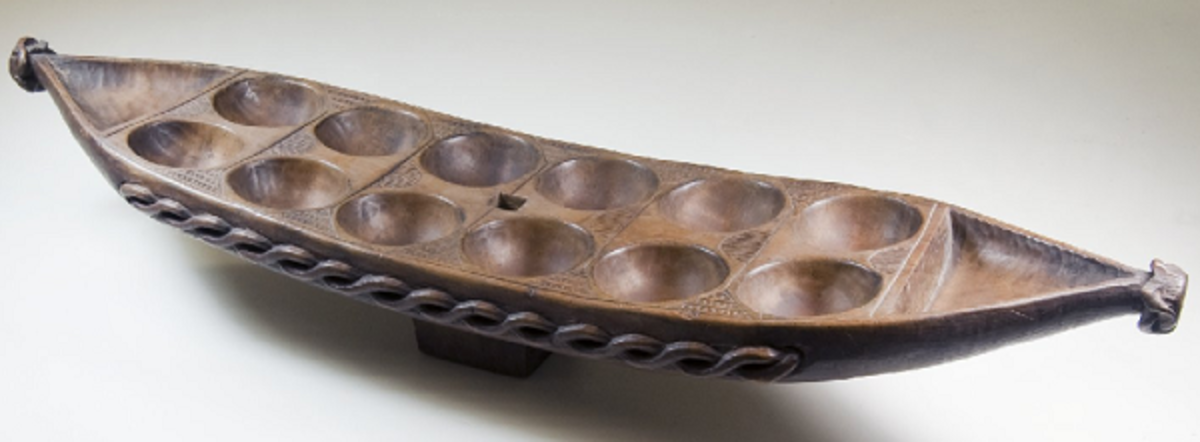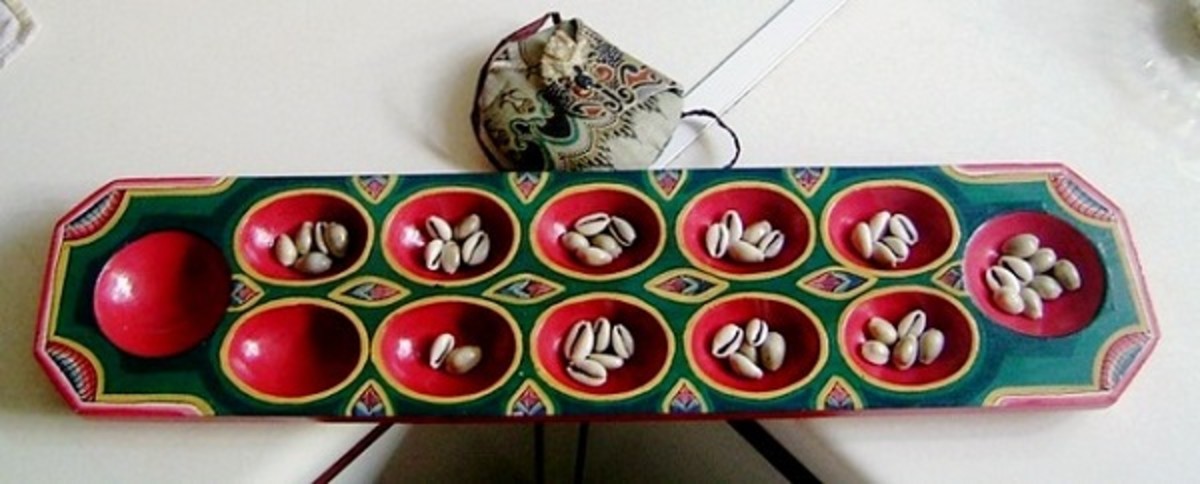 |
In the ancient days, mancala games, known by many names including opon ayo, awele, and oware, were played with small irregularly shaped stones in hollow holes dug out from the earth. The stones were placed in and moved around in a clockwise manner from one hole to the other. With time, the natives developed the art of carving wood or rocks to create playing boards while replacing the rough stones with large seeds, beans, cowries or seashells, depending on the geographical region of the players. Stone mancala boards have been found carved into the floors of temples in Memphis, Thebes, and Luxor.
Despite its age and primitive origins, the mancala game is a mathematical game of tactics that can be played with whatever medium happens to be around you. Some of its more complex versions have as wide a scope as that of a Chess game. The objective of the game is to accumulate more stones than an opponent, leaving him or her with no legal move and no choice but to concede.

Variations of Mancala Games
Opon Ayo
This is a traditional mancala game played by the Yoruba people of South-West Nigeria. It is composed of a wooden board with 2 rows of 6 holes each. 48 seeds are used, with 4 seeds placed in each hole. There are 2 players, and each player owns one row.
Oware
This genre of mancala is an abstract strategy game played worldwide with slight variations in the layout of the game. Though the origin of oware is not certain, it is believed to originate from the Ashanti people of Ghana.
Awari
This is another variant of the mancala game commonly played in Ivory Coast, on the west coast of Africa and is usually played by the elderly as a time-killer.
Awale
According to the Masai tribe of East Africa, awale was invented by the son of the first man, Maitoumbe, and was originally called geshe.
Awele
This is another member of the calculation game called Mancala. It is played by the Baule people, one of the largest tribes of Côte d'Ivoire (Ivory Coast). It, just like other variations, requires a carved wood board with 12 holes and 48 seeds. The board comes with two additional pits called score houses.

Beautiful mancala game board with cowrie shells as playing 'seeds'. Notice the delicate pouch that serves as storage for the cowrie shells.
There are hundreds of names attributed to the game, and this attests to the fact that there is an enormous range of the game and the people who play it. Other mancala board games are known as wale (Ivory Coast), Ambala (DRC), wari (Mali), Biri (Angola and Namibia), Bao la Kiswahili (East Africa), Hawale (Cameroon), and huri (Cape Verde). All these and many more are variations of the mancala game, but the principles behind each game remain the same: tactical, calculative, and strategic.
Generally, mancala game boards vary considerably in size, with the largest one, tchouba, with origins in Mozambique, and en gehé of Tanzanian origin. While Tchouba’s board consists of 160 holes and 320 seeds, the En Gehé is played on longer rows with up to 50 holes and 400 seeds. The smallest genres are the Nano-Wari and Micro-Wari. The nano-wari board has 8 seeds in just two pits, and the micro-wari has a total of 4 seeds in four pits.
Some other variations of the game have more rows, and thus, more holes on either side of the board. This genre of mancala is known as the 4-rank mancala board game. The 4-rank variation is played by four people and is a modern type which has become quite popular with today's players.

Cowrie shells and seeds are used for the mancala gameplay.
How to Play Mancala
Most Mancala games share a common gameplay where the players start by placing a certain number of seeds, prescribed for the particular game board, in each of the holes.
The mancala board is typically made of carved wood, but you will also find decorative board versions sculpted from natural stones like rock, granite or marble. While some boards are carved or sculpted with basic configurations, many are intricately designed with attached stands that depict animals that range from elephants, lions, and crocodiles. Some have figurine stands of carved figures holding up the game board.

How a mancala game board is configured - Rows, holes, and seed store pits.
The board consists of 2 long rows (or ranks) with each player’s row comprising 6 holes (or pits). The board has a total of 12 holes. Some boards come with 2 store pits at each end of the board, one for each player to store their winnings (seeds).
To start the game, each of the 12 holes (24 in 4-player games) is filled with 4 seeds. The first player picks up the 4 seeds from any of the holes in his/her row and distributes them in a clockwise manner, dropping one seed at a time and in sequence into holes around the board. In the next turn, the other player follows the same pattern on his/her row of holes. This means that a turn consists of removing all seeds from a pit and placing one in each of the following pits in order.
How an opponent captures seeds is based on the state of the board and the number of seeds (2 or 4) gathered in holes of an opponent’s row. This leads to “count and capture", a phrase used to describe the play. This general sequence applies to all Mancala games. To capture more seeds than an opponent, each move must be tactical, and the player who gathers the most seeds at the end of the game is the winner.
There are a few simple rules:
- The hole a player can drop a bead into.
- The process of collecting winnings.
- When a player's turn is over.
- Counting seeds to plot a game move.
Traditional and Modern Mancala Games
You can still find mancala boards that are old inheritances in some African and Asian homes. As they age over time, they have become smooth and worn through many years of use. They are mostly passed down from one generation to another and are great relics of the past. Plymouth City Museum and Art Gallery have what is probably one of the best mancala boards in any British museum (made by the Yoruba and Benin people of Nigeria) in its collections.

Traditional wood-carved mancala game with 2 rows of 6 holes each, and two seed store pits.

Modern 4-rank mancala board game made from engineered wood. A 4-player genre of the game.
Modern mancala board games are made from different kinds of materials that range from engineered wood and leather to acrylic, copper, bronze, marble, and tempered glass. They come in different shapes, forms, sizes, textures, and colours and can be open-cased or open-close hinged boxed mancala games.
(Article originally published by the author at Hubpages.com on 10/18/09)
Related articles
Smart Kids Are Making Money Online Testing New Video Games
